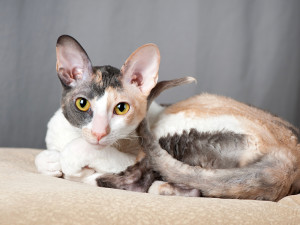Is ‘Orange Cat Behaviour’ Real?
Your TikTok algorithm would like you to think so, but the experts weigh in

Share Article
If you’re a cat lover – and you’re here, reading this article, so it feels pretty safe to assume that you are – you may have recently noticed your algorithm going extra hard on a specific type of cat content, ie orange cat content. Even more specifically, orange cat behaviour.
Although exactly what that is can be hard to pin down, based on the videos racking up millions of views on TikTokopens in a new tab, orange cat behaviour is generally endearing, often derpy, occasionally spicy and, at times, completely and utterly banal. And, in typical human fashion, everyone posting or engaging with such content seems to have a different definition of exactly what it is and feel very strongly that their definition is the right one.

littleKin™ is Kinship’s home just for puppy and kitten parents. Bop over to check out expert advice, new pet tools, and special deals—all curated for your newest family member.
opens in a new tabHaving grown up with an orange cat, (or ginger, as we prefer to call them in the UK) and recently fostering a ginger cat, my definition of ’orange cat behaviour’, were I to have one, would most likely be distant, stoic, independent and proud – and maybe a little ferocious. My mother’s cat, Sophie, was a lovely ginger tabby, and she and I never got along when I was a kid. I resented her aloofness, and she was not above making me bleed if I cornered her.
As for my foster Mufasa, well, three days into our association, he ripped a six-inch gash in my wrist when I tried to pick him up. Not his fault, of course; he was my first foster and I got cocky. He also broke a vase, knocked a 20kg mirror off the wall, scratched the surface of my dining table and ripped my trousers. It was a very eventful 10 seconds.
But, given that Sophie and Mufasa were both feral before they came into my life, attributing their behaviour to their orange-ness feels like a stretch. After all, causation and correlation are not the same thing. While I might prefer the story that their shared hostility towards me was caused by the colour of their fur, as opposed to their time on the streets or my own behaviour, that doesn’t make it true.
The facts: does being ginger really influence cat behaviour?
The fact is, at least according to science, there is no such thing as orange cat behaviour. “To date, no studies have shown any impact of coat colour on personality in cats,” veterinary behaviourist Dr Mikel Delgado tells Kinship. “There are survey-based studies that demonstrate that humans might think there are differences in cat behaviour or personality based on coat colour, however, no studies to date have found a relationship between coat colour and behaviour by actually testing cats.” The one study she is aware ofopens in a new tab found no differences in behaviour (shyness, activity, friendliness to a new person, etc) between cats with orange coats and other coat colours.
Of course, there are numerous studies that draw links between cat breeds and certain personality traits. However, analysis of these studiesopens in a new tab have found their conclusions are often flimsy at best, relying as they do on small data sets or people’s reported observations of their own cats’ behaviours. The problem with this kind of survey-based research is that every human participant will perceive traits like friendliness, aggression or shyness differently. Those same people are also more likely to note and report the traits that already fit the narrative they have for their cats and disregard or downplay the ones that don’t.
It’s more about cat parents than the actual cats
“If anything, the orange cat behaviour phenomenon is a great example of how good people are at finding patterns where they don’t actually exist,” says cat behaviourist Kristiina Wilsonopens in a new tab. “They hear or decide that orange cats act a certain way and when they do, the person makes note of it. But all the times they don’t act that way, their brains don’t really file the information away.”
Whether orange cat behaviour is real or not, believing in it certainly doesn’t do any harm, though. Or does it? After all, when you accept as fact that ginger cats behave a certain way because they are ginger, you are using the same flawed logic as people who insist that black cats are somehow mean or aloof because they are black. Stereotypes cut both ways, and believing in one makes it easier to believe in another.
Cat coat colour does relate to the sex of the cat
It is also worth noting that approximately 80 percent of orange cats are male. “This is because the gene for orange fur is sex-linked and only on the X chromosome,” Dr Delgado explains. “Females have two X chromosomes (XX), while males only have one (XY).” This means males only need to inherit the orange fur gene from one parent in order to be fully orange, while females need to inherit it from both; otherwise they will be born calico or tortoiseshell. And while orange cats are overwhelmingly male, calico and tortoiseshell cats are overwhelmingly female, according to researchopens in a new tab.
This is especially interesting when you look at the difference in the use of the term ’tortitude’ online, versus ’orange cat behaviour’. While ginger cats, who are usually male, are often characterised as silly and lovable, tortoiseshell cats, who are almost always female, are often framed as being sort of standoffish.
“I think there is a sort of sexism from the jump about the way we perceive these animals,” says Wilson. This is not to say that the people participating in the proliferation of these terms online are being sexist, or that calico parents adore their cats any less than ginger cat parents do. But it is always worth examining the ways our understanding of the world around us might be influenced by biases, whether we are conscious of them or not.
All this is to say that the way we perceive our cats (not to mention the rest of the world) often says more about us than it does about them. And the fact is that all cats, under the right circumstances, can be derpy or sly, standoffish or snuggly, no matter their colour, sex or breed.
References

Charles Manning
Charles Manning is an actor, writer, and fashion/media consultant living in New York City with his two cats, Pumpkin and Bear. Follow him on Instagram @charlesemanningopens in a new tab.
Related articles
![A cat outside showing its bottom teeth.]() opens in a new tab
opens in a new tabWhat’s All the Cat Chatter About?
Scientists believe they could be mimicking the calls of their prey
![Woman laying on her bed while hugging her cat]() opens in a new tab
opens in a new tabWhy Does My Cat Wake Me Up At the Crack of Dawn?
Here’s what to do when your cat starts pawing at your face before the sun has even come up
- opens in a new tab
Why Is My Cat Hiding?
No, they’re not on the lam. Here are four reasons your cat might be MIA
![Cornish Rex cat laying down on a pillow]() opens in a new tab
opens in a new tabThe Cat Breed-Behaviour Connection
Which cats are more likely to have stranger danger? Bite the hand that feeds them? Get the zoomies? Scientists studied 5,700 pet cats and discovered some interesting traits
![Cheerful Black Woman Caressing Cats On Couch]() opens in a new tab
opens in a new tab30 Strange Signs My Cat Is Happy
From puking on your least favourite shoes to biting you less (not zero, just less), here are all the ways to tell if your cat is actually happy
![Cat hissing at a person attempting to pet its cheek]() opens in a new tab
opens in a new tabDoes Your Cat Hate Your New Partner?
How to help your kitty warm up to your SO








